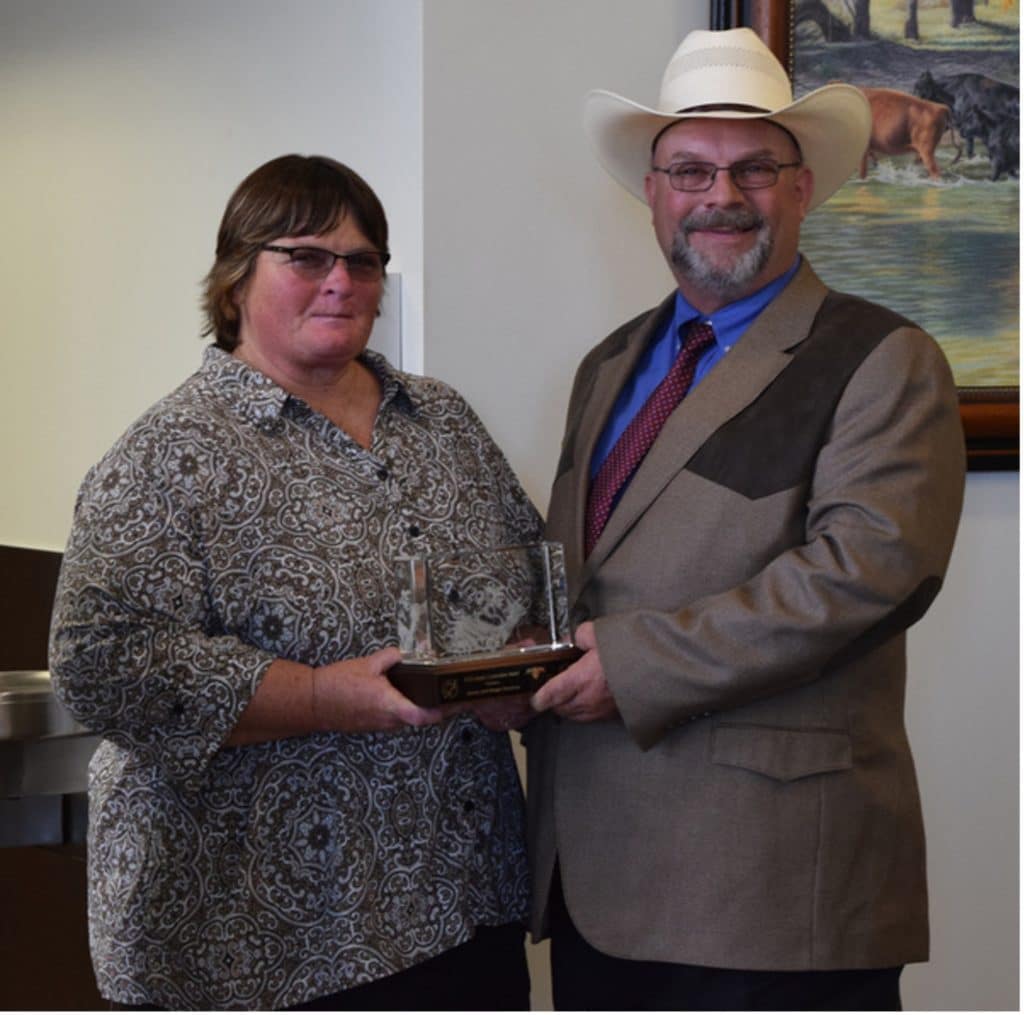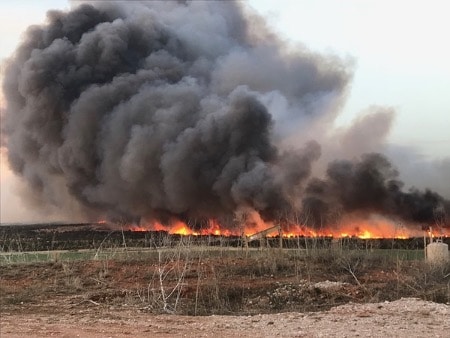Farmer and rancher offers windshield perspective a year after the 2018 wildfires
What was happening on the afternoon of April 12, 2018 in Oklahoma City was a dream for Jimmy and Ginger Emmons.
However, what was taking place back home near Leedey in western Oklahoma’s Dewey County was a fiery nightmare.

The Emmons had traveled to the capital city to receive the state’s first Leopold Conservation Award, given in honor of renowned conservationist Aldo Leopold. The award – presented by the Sand County Foundation, Oklahoma Cattlemen’s Association, Oklahoma Farming and Ranching Foundation, ITC Holdings Corp. and The Noble Research Institute — recognizes extraordinary achievement in voluntary conservation by American ranchers, farmers and foresters. On that day Jimmy and Ginger Emmons were presented with a $10,000 award, and a crystal depicting Aldo Leopold. It was a great day, until they got the phone call later that afternoon.
Friday marks the one-year anniversary of the start of that fire. Recently, Jimmy, sitting in Oklahoma City after attending a meeting of the Oklahoma Conservation Commission board, gave a windshield perspective of then and now.
He was not prepared for what he saw through the windshield of his black and gold 2017 Dodge pickup when he got close to home that day.
“The gut-punch that day was that the county was on fire, half of it burned,” he said, still shaking his head a year down the road. “It was extreme fire.”
Most nightmares end about the time the alarm clock goes off, but this one went for days. Jimmy was told later by Oklahoma Forestry Services personnel that the fire was burning 118 acres per minute as it went past his house that night.
“The original fire started one mile to the east of our property near Leedey,” Jimmy said of the Rhea fire. “Now the second day, a fire came by our house that day and then came up to the blackline as the wind shifted from the previous fire. Then it took off southwest that day.”
So Jimmy was asked, “What do you see through that windshield now, a year later?”
“When I pull up and we have a Conservation District board meeting, we have over 50 percent cedar control in Dewey County now” he said. “So that’s a very positive. Streams are running clear now of water that hasn’t run. So the availability of water through the cedar control is back to where it should be. So that’s really two great positives.”
The work continues.

“As you drive around, we had 23 miles of fence ourselves that we had to rebuild and we’re about a mile away from being done, so it’s been a whole year process,” Jimmy said. “As I drive around the county, I see the $15 million of fence infrastructure that was replaced. That’s all positive.
“Also, the County Commissioners have done a great job of removing trees, safety wise.”
Although Oklahoma experienced 436 wildfires in March 2018, the highest number in a single month last year (2018) came in April with 367,458 acres burned, reported the Oklahoma Forestry Services (OFS) of the Oklahoma Department of Agriculture, Food and Forestry ( ODAFF). Bear in mind that this is only the fires that OFS assisted with or suppressed statewide. The figure does not include fires suppressed by municipal and volunteer fire departments that were not reported.
“The Oklahoma Department of Agriculture, Oklahoma Forestry Services and local firefighters and many others played significant roles during and after the fires,” Jimmy said. “They helped for several days and did an outstanding job.”
While many days presented all-out-battles, it was April 12 that OFS has called the most challenging single day of last year with numerous large and devastating fires occurring. Two of the larger fires in western Oklahoma were the Rhea Fire (286,196 acres) and the 34 Complex Fire (62,481 acres).
Tragically the fire claimed two lives.
Property, including homes, livestock and equipment were also lost.
“There were lots of negatives,” Jimmy said, “don’t get me wrong.”
Those losses won’t be forgotten. And that’s part of the reason Jimmy is always looking to find something out of the challenges that can be turned into a positive in the future.
For Jimmy those include solid conservation practices.
It can be safely said that Jimmy has embraced conservation practices with the equivalent of a bear hug since taking over Emmons Farm. That’s not to say the previous generations didn’t exercise good stewardship. It’s just that he has gone full tilt, starting with the implementation of no-till practices on his nearly 2,000 acres of cropland.
Since, he has worked cover crops, crop rotations, and planned grazing management into his farming and ranching for the purpose of reducing soil erosion caused by both wind and water.
These are just a few of the steps he’s taken.

He’s seen the benefits of those efforts.
“I’ve really promoted soil health and have been just really into it for eight years and I can see the difference in our range land, because of our grazing management” he said. “Actually we were able to stop the fire on some of our property because we had cedar control. So we were able to set a backburn and not have it get away from us because of cedars.”
The Natural Resources Conservation Service (NRCS) provided more than $2 million in Environmental Quality Incentives Program (EQIP)Financial Assistance dollars covering almost 50,000 acres to help farmers and ranchers with recovery efforts associated with the conservation needs on their farms and ranches in Oklahoma. NRCS offered a sign-up period for the land owners affected by the 2018 and 2017 wildfires in western Oklahoma again in 2019 for EQIP financial assistance consideration as well. At this time, 63 people have applied for funding consideration.
It’s Jimmy’s desire that the view through that windshield will continue to improve with every week, month and year.
